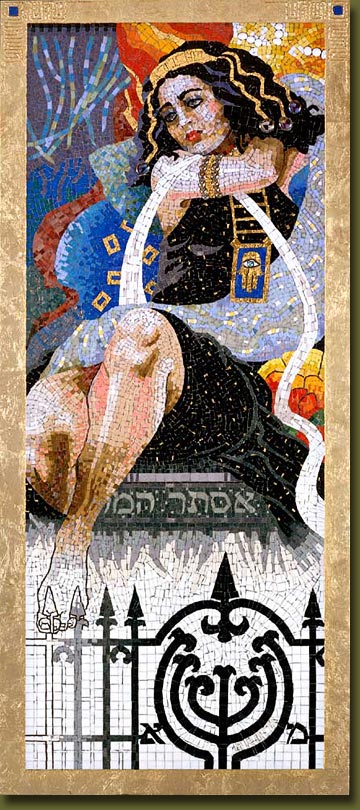
Lilian Broca, Queen Esther (Venetian glass mosaic, 2002)
Throughout my career I have explored relationships and the nature of the human condition through symbols and metaphors. The Queen Esther Series deals with sacrifice and I chose the biblical Queen Esther as a prototype for the courageous, selfless heroine who wins against all odds. As a young woman, Esther fulfilled her role as leader at a time of crisis with intelligence, persistence and dedication. Today we view her as a role model and as such, she contributes significantly to the status of women in society.
The bright, seductive colours of Venetian glass and smalti I used in creating mosaics many years ago, suddenly beckoned me. The coincidental fact that mosaics were first mentioned in the biblical Book of Esther (within the description of King Ahasuerus’s palace) contributed to my decision to further explore this unique art form. In our present Post-Modernist society executing the Esther Series in an ancient method with added contemporary symbolism seems most appropriate.
Esther exemplifies the theme of sacrifice. She was totally disinterested in becoming a candidate to be crowned Queen, and the text emphasizes that she was taken to the palace against her will. Like all obedient women of antiquity, Esther complied with given instructions and continued doing her uncle Mordechai’s bidding, even after being crowned Queen.
As Queen of Persia, Esther was as inferior in status as any other woman. Her life at court was luxurious, but since she was completely isolated in the King’s harem amongst women of a different culture and customs, she must have felt lonely and sad. Esther first sacrificed her maidenhood; later she was obliged to put her life at risk when ordered to go before King Khashayarsha (without the King’s permission) and reveal the treacherous plans Haman had designed without the King’s knowledge. She knew the danger to her was great and immediate, for anyone who approached the court uninvited was liable to be condemned to death. She wisely designed a plan in which she played King Khashayarsha (aka Xerxes, Ahasuerus, and Ahashverosh) and evil Haman against each other. It is my intent to portray Esther as a glorious winner, despite all the demands and sacrifices required of her in a patriarchal culture of antiquity.
More cover art: Doug Fogelson, Deluge
Ron Pokrasso, Altered Tune With A Connection To St. Johns Place
Anonymous, Shofar Kid
Gene Feldman, Color Test
Patricia Albouhair-Taieb, Thou Shalt Not Take the Name of the Lord in Vain
Mina Dareshet, Ocean
Mindy Stricke, Self-portrait
Jesse Mintz-Roth, untitled
Lynne Marie, Movement
Bill Bragg, Defending the Post
Jay Michaelson, Nighttime road
Allyson Grey, Magic Square
Shirah Rachel Apple, Alef 2
David Katz, The Evil Bush Administration
Lauren Curtis, Flora meets Arcadia
John Hall, Untitled
Pamela Yates, Summer Sleeping
Paul Mindell, Greens, Jeans, and InBetweens
Jay Michaelson, Mayflowers
Bara Sapir, untitled
Bara Sapir, untitled
Jay Michaelson, Ice Tree Jay Michaelson, untitled
Jay Michaelson, Eldorado Chanukah
Jose Campos, III, untitled Jay Michaelson, Shofar Kitsch
Mica Scalin, Plates
Mica Scalin, Untitled
Jay Michaelson, Go in Peace
Mica Scalin, Hope
Mica Scalin, Plague Cookies
Jay Michaelson, The Park in Winter







